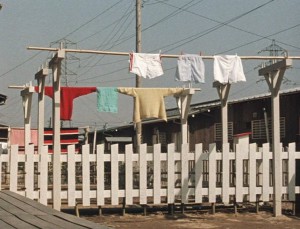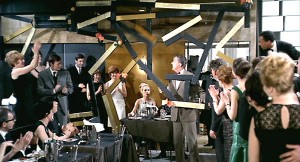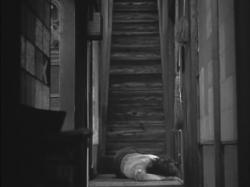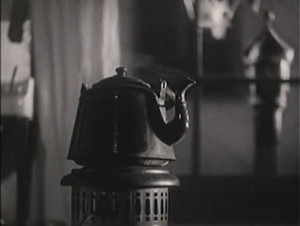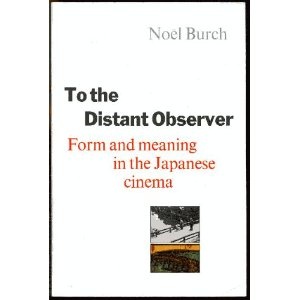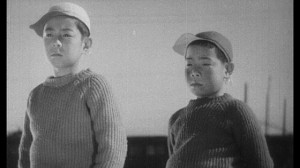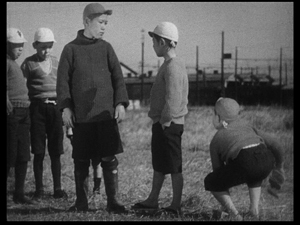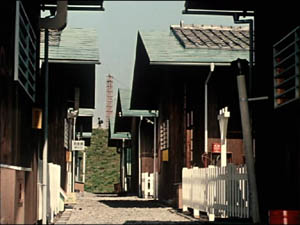Unfortunately, Richie’s division of Ozu into successive stages of ‘creation’ inevitably leads to the erection of a Platonic ideal, an all-purpose model of ‘the’ Ozu film — an unrigorous model indeed when what one concretely has to contend with are films, each with its own peculiar set of conditions and stresses. Since Richie has more production details about the later films, these tend to dictate most of the dimensions of the model, and the lost films implicitly become subsumed in the same homogenising process whenever Richie speaks about the entire body of the work. The usual approach is to lump together examples of certain aspects or procedures, leading to the formulation of such generalities as ‘the Ozu family’. This results in a profusion of catalogues, some quite nonsensical in presumed meanings and applications: ‘Another pastime to which the Ozu family is addicted is toenail cutting, an activity which seems worth mentioning because it occurs possibly more often in Ozu’s pictures (Late Spring, Early Summer, Late Autumn) than in Japanese life.’ In the long run, individual works are made to seem important or unimportant insofar as they help or fail to exemplify the hypothetical model.
Problem No. 4. Which leads us to the sticky matter of Richie’s evaluations. There is a running theme in Ozu about what is bad and good in the director’s work. What is good can be summed up by the word ‘humanity’; what is bad is ‘formalism’ (identical to ‘mere formalism’):
‘Without the rigorous frame that is the director’s technique, the intense humanity of the character could not be so completely revealed. Without the useless and lovable humanity of the Ozu character, the film’s structure would degenerate (as indeed it sometimes does) into mere formalism.’
‘Though sometimes the “empty” scene, whether or not it has people in it, seems almost formalistic . . . usually it is correctly formal in the sense that it is an integrai part of Ozu’s dramatic construction and serves to convey his interpretations.’ ‘With true art — the art that art conceals — Ozu triumphs in making a formal device appear natural.’
These are terms worth considering. As Richie uses them, it means that a formal device is ‘natural’ if it is invisible, i.e. if it dissolves into ‘humanity’, ‘the way things are’, ‘the way life is’, without showing us that it is showing us that. At one point, after an effective analysis of the compositional shifts during a family get-together in The Brothers and Sisters of the Toda Family (1941) — a film that, shot for shot, must be one of the most beautifully composed works in cinema, with characters and upper-class domestic settings integrated in gift-box arrangements which never cease to amaze — Richie adds, almost apologetically, that ‘All of this . . . is done with such naturalness and ease that it does not draw one’s attention to the composition (unless one is writing a book about Ozu) . . .’
Since I don’t happen to be writing a book about Ozu and do think about Ozu’s formal devices (which include his characters), Richie’s analysis would have it that I’m being ‘unnatural’. But this viewpoint is based on an either/or premise that impoverishes the potentialities of films and spectators alike. For a director like Ozu, whose brilliance and fascination largely rests on the virtual interchangeability of social and cinematic forms, it is merely myopic to assume that we must pay heed to one and ignore the other: why can’t we attend to both?
That such an awareness does work against sentimentality, simple identification and blindness to the medium is worth stressing. In a spirit comparable to Richie’s, Andrew Sarris once described Playtime as a ‘non-human comedy’ — apparently forgetting the people it was about and addressed to, not to mention the person who made it — and surely it would be hard to find a better instance of another expression of equivalence between social and cinematic forms. The point isn’t whether one sees it as cinematic forms expressed in social terms or as social forms expressed in cinematic terms, but the fact that Ozu and Tati operate in a context where both registers and viewpoints are fully at work (or at play, if one prefers). To attempt to see one at the expense of the other is to see only half a film.
In Woman of Tokyo — which concerns a young woman secretly working as a prostitute to help pay for her brother’s education, until he discovers the fact and kills himself – the ‘unmotivated’ dolly along the street which closes the film is formally prefigured in an earlier sequence. Here another, apparently unmotivated dolly along a street eventually catches up with the footsteps of the agitated brother after a fight with his sister, so that the tension between human absence and presence in this shot prepares us for the disturbing absence in the shorter dolly at the end. Fifteen years later, in A Hen in the Wind (1948) –- in which a husband returns from the war to discover that his wife worked briefly as a prostitute to pay for their sick child’s medical bills — the climactic scene of the husband pushing the wife down a flight of stairs is itself ‘prepared for’ by a previous scene in which a metal container is no less accidentally sent toppling down the same steps. The wife’s implied equivalence to an object is thus a function of both the husband’s shame and his frustrated response to it. In a film where even the more obtrusive ‘Hollywood’ elements — such as the staging of the final clinch when the husband forgives his wife — testify to Japan’s devastation by the war, Ozu’s formalism once again serves to objectify all the elements at hand; and the difference between the ‘unresolved’ despair at the end of Woman of Tokyo and the more conventional resolution of ‘adjustment’ in A Hen in the Wind may well be more a reflection of Japanese history than of any autonomous evolution on Ozu’s part isolation from this. **
But in both instances, our grasp of the characters and their problems is inextricably bound up in our capacity to notice these and countless other formal elements, rather than try to share the characters’ consciousnesses. (To promote this separation further, Ozu shows us virtually nothing of the brother’s school experience or the sister’s experience as a prostitute in the former, just as the latter is equally reticent about the husband’s career as a soldier and the wife’s episode as a geisha: all these ‘facts’ are established mainly by their consequences. Nor is there any moral judgment: the very notion of an Ozu villain is unthinkable.) And spectators who find Ozu’s films boring and uninvolving are, as likely as not, responding passively to this enforced distance: accustomed to viewing cinema as ‘life’ and not as cinema, they are denied access to Ozu’s intelligence as well as their own.
Even without any evident desire to foster this stalemate, Richie’s anti-formalist approach can ultimately serve only to promote it. Whereas for a Russian formalist like Boris Eikhenbaum, film ‘comes into being as a result of turning nature into material,’ for Richie it appears to follow an inverse route. But one man’s ‘life’ or ‘nature’ is often another man’s platitude: who is Richie to say that the dolly closing Woman of Tokyo makes us feel ‘as though the film, like life, could have gone on forever,’ when much of its cryptic power is to take us away from the comfort of such banalities?
A particularly unfortunate casualty of Richie’s impressionistic illusionism is his treatment of Ozu’s unconventional attitudes toward editing continuity which are regarded as ‘unaccountable lapses’ at best, ‘unnatural’ eyesores at worst:
‘For a director with a style so severe, an outlook so austere, Ozu could be incredibly untidy. Perhaps we are mistaken in equating austerity with neatness, but . . . we are still left with unaccountable lapses in Ozu’s films. Actually, Ozu was meticulous about his script, rigid about his editing, severe with his actors, but relaxed when it came to the actual shooting. There is no other way to account for the lapses of continuity in his films. In A Woman of Tokyo (sic) the teapot is bubbling away in the background, steam rising. Ozu cuts to, of all things, a close-up of the pot itself. No steam, no bubbles, an apparently cold teapot. Then back again to the heroine: no time has passed, it is the same scene. The director simply had not noticed that the pot was bubbling away in one scene (sic) and not at all in the next.’
More accurately, one might say that in the same scene Ozu cuts from an ostensibly steaming pot in the background to an only slightly steaming pot in the foreground –- succeeded next, if memory serves correctly, by a smoking chimney. But the implications remain, and comparable continuity lapses are observable throughout Ozu’s work, whether in the frequent ‘mismatching’ of successive gazes between conversing characters, or — to take an isolated example from Tokyo Story (1953) cited by Richie — the cut from the grandparents seated on the Atami sea wall to another shot of the same couple seated in reverse positions. Richie actually attempts to excuse some of these switches by asserting that ‘Often one is too interested and involved in the film to notice’; and it must be admitted that they usually escape the attention of most spectators, at least on a conscious level. Nevertheless, it is revealing that Richie assumes ‘the film’ to be somehow distinguishable from the succession of images composing it, and ‘interest’ and ‘involvement’ a matter of ignoring these images. And he is less forgiving about ‘Ozu’s passion for composition at the beginnings of his films, where carefulness can be obtrusive, or where it becomes obsessive.’
***
As a bracing alternative to this reductive reasoning, it is worth considering the more sophisticated methodology used by Noël Burch in relation to virtually the same phenomena — Ozu’s discontinuous editing and his compositions without human presences — in a forthcoming study of Japanese cinema, scheduled for publication by Secker and Warburg, which Burch has kindly allowed me to quote from here. Although a brief examination of ‘The model systemics of Ozu Yasujiro’ in this context cannot do justice to the range of its argument, a few samples might be illuminating.
Inscribed within a Marxist framework and making certain uses of semiological disciplines, Burch’s analysis treats the two phenomena cited above as procedures which decisively challenge the assumptions and ‘codes’ of Western cinema in general and Hollywood in particular. The principal form of discontinuous editing discussed by Burch is the ‘false’ matching of the directions of successive gazes in relation to the spectator:
‘. . . A reverse field series in his mature work is seen as a succession of flat surfaces “side by side” rather than face to face; there is no imaginary space between them in which to ensnare the subject, as it were, for there is no encounter of any projecting eyelines (the necessary complements in Western cinema of the receding and converging parallels of deep space). Similarly — and this is particularly true of Ukigusa Monogatari [A Story of Floating Weeds, 1934l and Hitori Musuko [The Only Son, 1936] — the systematic neglect of direction-matching (of frame exits and entrances) tends to prevent successive shots of a given interior from “flowing into one another naturally”: the mental reconstitution of a three-dimensional space on the basis of these “badly joined” flat images requires a considerable effort of memory and imagination, i.e. a reading.’
In the case of Ozu’s shots without human presences — which some critics have called ‘still lifes’ (although, as Burch notes, landscapes occasionally fill the same function, and in Ozu’s silent films these shots aren’t always motionless), and which Burch designates as ‘pillow-shots’, after the ‘pillow-word’ of classical Japanese poetry – the implications are at times equally disruptive and provocative:
‘…any prolonged or diagetically “unmotivated” absence of human beings from the screen in a fiction feature film (unless the images are so heavily connotated as to function like titles, conveying such clear, unambiguous messages as “Sunday” or “Spooky house” is received as a departure from the codes, taking the form of a poetic message in a film like Antonioni’s L’Eclisse or a more fundamental critical aggression in Paulino Viota’s Contactos.’
Perhaps more to the point, Burch quotes from a particularly beautiful and relevant passage in Roland Barthes’ L’Empire des signes:
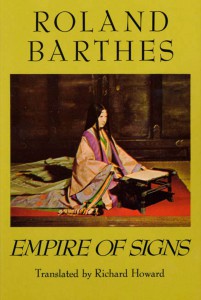
‘…Perhaps what is called satori in Zen and occidentals can only translate with vaguely Christian words (illumination, revelation, intuition), is simply that panic suspension of language, that blank which blots out of our minds the reign of the Codes, the breaking off of that interior recitation which constitutes our self; and if this state of non-language is a liberation, it is because the Buddhist experience regards the proliferation of second degree thoughts (the thoughts of thought), or the infinite supplement of surplus signifieds, if one prefers to call it that – the circle of which language is both the repository and the model — as a kind of block: on the contrary, it is the abolition of second degree thought that breaks out of the vicious infinity of language. In all of these experiences, what seems to be at stake is not to crush language under the mystical silence of the ineffable, but to measure it, to arrest that spinning verbal top which powers by its whirling fury the obsessional play of symbolic substitutions. In short, it is the symbol as semantic operation which is under attack.’
To which Burch adds: ‘And what could be more acutely inimical to that perfect example of the compulsive production of meaning supplied by the Hollywood codes than the blank beauty of an Ozu pillow-shot?’
***
At which point we have described a full circle — from Richie’s assertion that the ‘carefulness’ of an Ozu composition can be ‘obtrusive’ or become ‘obsessive’ to the statements of Barthes and Burch, which imply that it can suspend an ‘obsessional play of symbolic substitutions’ and a ‘compulsive production of meaning’…Whether one chooses to agree with all the ideological ramifications of Burch’s position is, of course, another matter; but it is worth noting that his specific analyses have som expositional value apart from their polemical context, and it is hardly essential to ‘agree with’ every one of his conclusions in order to learn something from his arguments.
At the same time, his definition of what constitutes Ozu’s ‘mature’ work — a ‘penchant for strict formalisation [in I Was Born, But . . . Passing Fancy and Tokyo Chorus] which will lead first to the unparalleled beauty of the later thirties and early forties [in A Story of Floating Weeds, An Inn at Tokyo, The Only Son, Brothers and Sisters of The Toda Family and There Was a Father], and then, through a gradual fossilisation, to the academic rigidity of the post-war period’ — deserves some serious consideration, particularly in relation to the relative importance accorded by Richie and other critics to the postwar work (Late Spring, Tokyo Story, An Autumn Afternoon, etc.) The latter view, which tends to value Ozu more for ‘transcendental’ qualities and an austerity or ‘purity’ of means, effectively regards most of the early films as stepping-stones toward these late ‘testament’ works. Burch’s non-illusionist and formalist view places greater value on the ’threshold points’ of Ozu’s purification of style — e.g., when his use of camera movements became dictated by ‘organisational’ strategies and before he virtually eliminated them, or when he belatedly took up sound and experimented with its possibilities (in The Only Son) before using it more conventionally. (One could add the tentative hypothesis that Ozu’s first use of colour, in Equinox Flower, was more adventuresome than in his subsequent films. Note from 2017: This is far from the truth. A cursory look at Equinox Flower shows a use of colour that is far from adventurous, unlike the complex and often riotous uses of colour in Good Morning, Ozu’s subsequent film.)
As most of my own recent viewing of Ozu’s work has been concentrated on the pre-war period, I find it difficult to make a choice myself out of anything more than memory or hearsay, although theoretically at least, Burch’s preferences appear somewhat more persuasive. This became especially evident when I had occasion to see Woman of Tokyo twice, roughly three months apart: initially after reading Richie, and subsequently after reading Burch. The first time, it seemed like little more than a perfunctory potboiler in relation to Days of Youth (which was screened just before), unaffecting and remote-as Richie puts it, ‘Another romantic melodrama, this one a quickie.’ I was persuaded, too, by Richie’s arguments about the ‘weakness’ of certain transitional devices, such as a cut from a clock in a room which the brother’s fiancée has just left to answer a phone to a wall full of clocks in a shop where the fiancée is receiving the call: ‘One feels at once that the call from the clock shop is only a flimsy pretext for the clock transition.’
Yet seen again, in the light of Burch’s analysis, a number of, things about the film became apparent. The discontinuity of certain cuts (including those involving the steaming teapot), the ‘unmotivated’ dolly at the end, and the fancy clock transition – along with a great deal more—became part and parcel of a distanciation from the characters, to a degree quite unusual for Ozu at that period, that suddenly brought the film beautifully to ‘life’. What originally had served as a stumbling block -– Ozu’ pronounced formalisation of shots and movements which repeatedly abstracted the plot from any possibility of sustained identification — gradually became a lever into something quite different: not merely what the characters were saying and doing, but what Ozu was ‘saying’ and doing through them, which, far from conveying remoteness, constituted a very special kind of intimacy.
Obviously we all have a lot further to go before we can begin to understand what Ozu is about; a full-scale Ozu season that is currently being planned at the National Film Theatre will hopefully be a step on the way. A great deal remains to be deciphered and penetrated, on a sheer textual level as well as theoretically, (What, for instance, is the meaning of the fireworks displays that momentarily punctuate the narratives of Passing Fancy and An Inn at Tokyo?) Quite a bit more remains to be enjoyed: the extraordinary physicality and expressiveness of father and son in Passing Fancy; the extended song sequence in The Record of a Tenement Gentleman (1947); the short dollies through an empty Noh theatre in Early Summer. But in the meantime, a lot will be gained when critics like Richie — already so useful for their arsenal of background and biographical information begin to sharpen up their critical methodologies as well.
**A similar difference can be seen between the more tragic implications of the young boys’ rebellion against their father in I Was Born, But . . (1932), which exposes a sense of society’s limitations, and the sunnier, more ‘philosophical’ stance of Good Morning (1959), the ‘remake’, where these limitations — and comparable cinematic curtailments — are more or less taken for granted, circumscribing a view of middle-class suburbia that no longer deviates far from the norms of light comedy.

